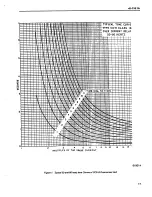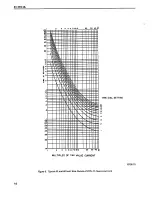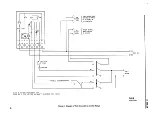
41-116.1A
4
reclosing will be initiated immediately after a trip by
the CO contact, the time of the opening of the con-
tacts should be a minimum. This condition is
obtained by loosening the stationary contact mount-
ing screw, removing the contact plate and then
replacing the plate with the bent end resting against
the contact spring.
For double trip relays, the upper stationary contact is
adjusted such that the contact spring rests solidly
against the back stop. The lower stationary contact is
then adjusted such that both stationary contact make
contact simultaneously with their respective moving
contact.
4.2. INDICATING CONTACTOR SWITCH (ICS)
There are no settings to make on the indicating con-
tactor switch (ICS).
4.3. INDICATING INSTANTANEOUS TRIP (IIT)
The proper tap must be selected and the core screw
must be adjusted to the value of pick-up current
desired.
The nameplate data will furnish the actual current
range that may be obtained from the ITT unit. It is
recommended that the IIT be set on the higher tap
where there is a choice of tap settings. For example,
for a 20 ampere setting use the 20 to 50 tap rather
than the 6 to 20 tap.
4.4. VOLTAGE UNIT (V)
The voltage unit
spring calibration is set to close its
contact when the applied voltage is reduced to 80
volts. The voltage unit can be set to close its contacts
from 80 volts to 100 volts
by adjusting the resistor
located at the top left of the voltage unit. The spiral
spring is not disturbed when making any setting other
than the calibrated setting of 80 volts.
5. INSTALLATION
The relays should be mounted on switchboard pan-
els or their equivalent in a location free from dirt,
moisture, excessive vibration and heat. Mount the
relay vertically by means of the four mounting holes
on the flange for the semi-flush type FT case. The
mounting screws may be utilized for grounding the
relay. External toothed washers are provided for use
in the locations shown on the outline and drilling plan
to facilitate making a good electrical connection
between the relay case, its mounting screws and the
relay panel. Ground wires should be affixed to the
mounting screws as required for poorly grounded or
insulated panels. Other electrical connections may
be made directly to the terminals by means of screws
for steel panel mounting.
For detail information on the FT case refer to IL
41-076 for semi-flush mounting.
6. ADJUSTMENTS AND MAINTENANCE
The proper adjustments to insure correct operation of
this relay have been made at the factory. Upon
receipt of the relay, no customer adjustments, other
than those covered under “SETTINGS”, should be
required.
The Indicating Instantaneous Trip unit (IIT) used in
some relays requires a much higher current for trip-
ping than is required by the other units. For this rea-
son, the junction of the CO unit coil and the IIT unit
coil is brought out to switch jaw no. 3 (whenever it is
available) to permit the testing of these units sepa-
rately.
When applying current in excess of 50 amperes
to test the IIT, the current should not be left on
while adjusting it to the trip level. Instead, apply
the current in short bursts, not more than 2 sec-
onds long, to check for tripping. Make adjust-
ments in the current control while the current is
off.
High currents left on for excessive time periods
can result in the softening and possible melting
of insulation the interconnecting wires.
6.1. OPERATIONAL CHECK
The following check is recommended to insure that
the relay is in proper working order. (See Figure 9.)
6.1.1. Overcurrent Unit (CO)
The directional unit contacts must be in the closed
position and the “T” unit picked up when checking the
operation of the overcurrent unit.
A. Contact
1) By turning the time dial, move the moving
!
CAUTION





































